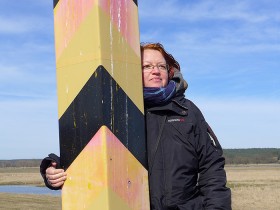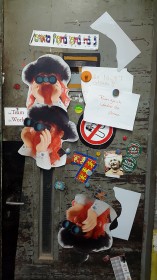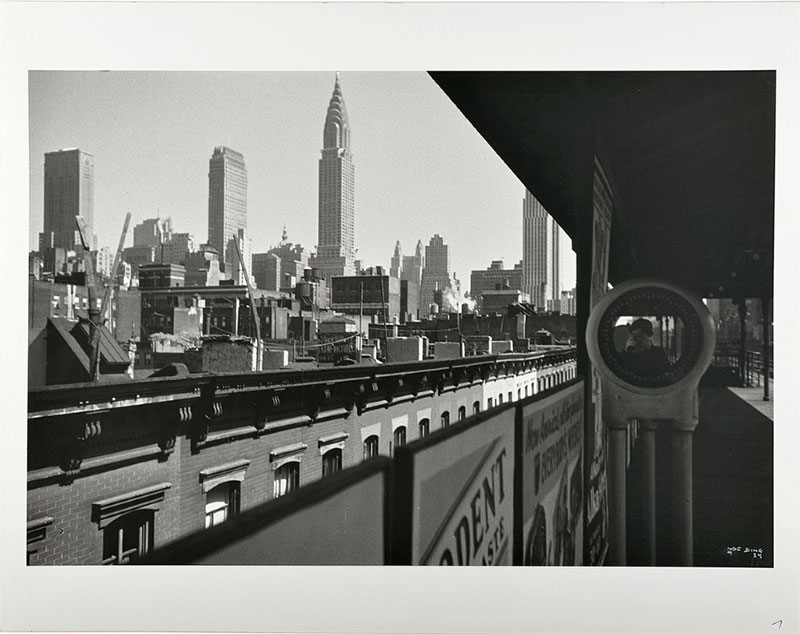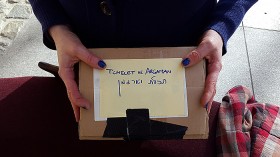
Anna Adam, “Pastoral care for a German-Polish border post”, March 2015 © Jalda Rebling
It’s not easy to find the way there. Good thing that the artist picked me up at the nearest subway station in Berlin’s Wedding district. Together we cross the courtyards of various businesses, pass a halal diner, climb a staircase, and suddenly we’re standing in front of the door of her atelier. Hardly has Anna opened it when I see the “kosher gnome”, observing the world through his binoculars.
It’s this figure that the artist reproduced in paper cut-out form on a card for our art vending machine: you cut the card and fold it to create a three-dimensional object. The instructions state that you should set him in your kitchen and then everything will be ok.

Atelier Door with “Kosher Gnome” © Jewish Museum Berlin, Photography: Gelia Eisert
Anna, what does the odd name “kosher gnome” mean? How do “kosher” and “gnome” even fit together? How will everything be ok? I’m confused.
At home, a wichtel (in the original German) is an important little man. There are a lot of these “important men”. My “kosher gnome” was born in 2002. He’s definitely supposed to be confusing. “Kosher” and “gnome” fit together because I committed myself to the task of “healing the German-Jewish sickness”, as I call it. To that end I work with satirical means, which – unlike comedy – take everyday politics as a starting point.
You mentioned the year it was born. What were the circumstances of the “kosher gnome”‘s birth? → continue reading
A self-portrait shot by Ilse Bing on her first trip to New York in 1936 has been imprinted on my mind’s eye for a very long time. The image was up for sale only twice in the last twenty years. On the first occasion, in 2009, a vintage print went at auction for the princely sum of 25,000.00 EUR. Given its rarity and great market value, I imagined at the time that the enchanting image was unlikely ever to become a part of our collection. For me, it came to be the very epitome of wishful thinking.

Ilse Bing, “New York—The Elevated and Me,” print from 1988 of the original negative from 1936. Jewish Museum Berlin © Estate of Ilse Bing
The photograph depicts a station on the Elevated (subway line) in New York and the reflection in a small round mirror of the photographer with her Leica. The title “New York—The Elevated and Me” underscores the hybridity here of cityscape and self-portrait.
→ continue reading

When delivering her art works to the Jewish Museum Berlin, Deborah S. Phillips naturally wears blue nail polish © Jewish Museum Berlin. Photo: Gelia Eisert
A visit to Berlin-Neukölln, to the studio apartment of Deborah S. Phillips, who is dressed in blue, today, except for her shoes, which are green. That the artist has spent the last five years examining the color blue and is only now gradually turning her attention to hues of green is reflected thus in her apparel as well as her art.
Red was the first color to which Deborah Phillips devoted herself with a passion. The Bible story she read aloud as a 12-year-old in the synagogue on the occasion of her Bat Mizwa was about the red cow—and it haunted her for ages. It was the tale of a strange animal that had to be sacrificed so people could use its ashes to cleanse themselves of sin. Only then would they be able to enter the temple in Jerusalem. Many years later, Deborah Phillip’s reflections on the color red and its cultural significance culminated in one of her enchanting works on paper, the “Red Book,” which is the fruit also of the artist’s extensive voyages in Iran, India and Central Asia, and her affinity with Islamic cultures. → continue reading



